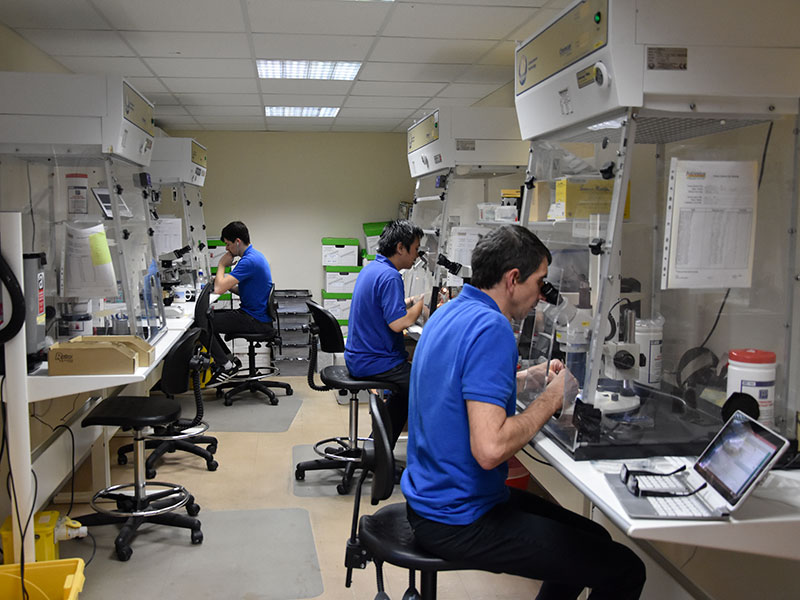The Complete Process of Accredited Asbestos Evaluating to Make Certain Building Compliance
In the realm of home monitoring and compliance, the process of recognized asbestos screening stands as a vital part to ensure the security and wellness of owners. Recognizing the intricate steps included in this testing method is extremely important for residential property proprietors and managers alike. From the initial assessment to the final interpretation of results, each stage plays an important function in figuring out the visibility of asbestos within a residential or commercial property. Let's check out exactly how this careful procedure unravels to ensure adherence to rigid guidelines and secure against prospective health and wellness dangers.
Accredited Asbestos Screening: Preliminary Assessment
In conducting the initial evaluation for approved asbestos testing, a careful examination of the building's materials is critical to accurately determine possible asbestos-containing products. Unique focus is offered to materials that are prone to harm or disruption, as these situations can release dangerous asbestos fibers into the air.
Certified asbestos assessors comply with strict protocols established by governing bodies to guarantee the accuracy and integrity of the testing process. By thoroughly recording searchings for and utilizing advanced screening techniques, assessors can supply residential property proprietors with a comprehensive record detailing the existence of asbestos, if any kind of, and the advised steps for mitigation or removal. This first analysis sets the foundation for subsequent activities to address asbestos concerns and guarantee the security and compliance of the residential property.
Example Collection Procedures for Asbestos Testing
Reliable sample collection treatments are important in making sure precise asbestos screening results and compliance with governing criteria. When gathering examples for asbestos testing, it is critical to adhere to stringent methods to decrease the danger of contamination and guarantee the reliability of the outcomes.
First of all, it is necessary to recognize the presumed asbestos-containing materials (ACMs) and focus on sampling locations based on elements such as the product's condition, ease of access, and potential for disruption. Asbestos Testing. Samples must be collected from numerous places within the residential or commercial property to give a detailed assessment of asbestos visibility
Throughout sample collection, licensed professionals need to wear ideal personal safety equipment (PPE) to secure against asbestos exposure. They have to utilize clean devices, such as disposable handwear covers and plastic bed linen, to protect against cross-contamination between examples. Samples should be very carefully gathered utilizing a defined technique, such as wet cleaning or coring, and securely secured in impermeable containers to preserve their stability throughout transportation to the lab for evaluation.
Laboratory Evaluation Refine for Asbestos Examples
Upon conclusion of the example collection process, the asbestos samples are diligently transferred to accredited research laboratories for careful evaluation. The initial step in the research laboratory analysis process is sample preparation, where the collected examples are carefully refined to draw out the asbestos fibers.

As soon as the evaluation is complete, an in-depth report is produced, laying out the searchings for and validating whether asbestos exists, the sort of asbestos fibers determined, and the focus degrees. This information is important for homeowner to take the required steps to ensure compliance with asbestos laws and secure the health and wellness of owners.

Reporting and Analysis of Asbestos Test Outcomes
Approved asbestos testing labs offer in-depth reports that supply essential understandings into the existence, type, and focus degrees of asbestos fibers located in samples accumulated from buildings. These records are essential for property proprietors and managers to recognize the risk presented by asbestos and make educated decisions regarding its management or elimination. The records commonly include details on the techniques used for testing, the locations from which samples were taken, the kind of asbestos determined (such as chrysotile, amosite, or crocidolite), and the concentration levels of asbestos fibers found.
Interpreting these results why not try this out calls for know-how to analyze the possible health and wellness risks connected with asbestos direct exposure, figure out the suitable training course of activity, and ensure regulative conformity (Asbestos Testing). Relying on the searchings for, suggestions may vary from continued surveillance and upkeep to encapsulation or full asbestos reduction. Residential or commercial property proprietors should meticulously review these records and seek advice from asbestos specialists to create a comprehensive prepare for attending to any asbestos problems recognized
Guaranteeing Home Compliance With Asbestos Regulations
To keep adherence with asbestos policies, residential property proprietors need to faithfully carry out steps to More Bonuses make certain compliance with suitable regulations and standards. As soon as asbestos is recognized, building proprietors must comply with asbestos monitoring prepares that synopsis correct control, elimination, or encapsulation procedures to protect against direct exposure and spread of asbestos fibers.
Property proprietors need to offer asbestos awareness training to staff members and owners to decrease the danger of asbestos exposure and guarantee proper handling of materials that might contain asbestos. Additionally, it is vital to remain educated regarding any type of updates or changes in asbestos regulations to change management practices as necessary. By proactively addressing asbestos conformity requirements, homeowner can produce a secure setting for passengers and reduce possible legal and health and wellness threats connected with asbestos exposure.
Final Thought
In conclusion, certified asbestos screening is a crucial procedure for making sure residential or commercial property compliance with laws. The preliminary assessment, sample collection treatments, research laboratory analysis, and interpretation of outcomes are all crucial action in this imp source process. By following these treatments, building owners can determine and address any type of asbestos dangers present, protecting the health and safety and security of passengers and maintaining conformity with regulative requirements.